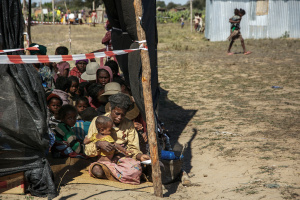Desolate villages face famine in Madagascar drought
General |Author: AFP | September 22, 2021, Wednesday @ 08:59| 37236 views
Beneficiaries wait their turn to be consulted by Doctors Without Borders (MSF) mobile clinic medical staff in the village of Tanarake, Commune of Sihanamaro, on September 1, 2021. Since March 2021, MSF has set up a permanent presence in the South of Madagascar, in Amboasary Atsimo and Ambovombe, in order to urgently help populations. Since June 2021, MSF has set up several mobile clinics to treat the most serious cases of moderate and severe malnutrition. (RIJASOLO / AFP)
(AFP) - Nothing to eat, nothing to plant. The last rain in Ifotaka fell in May, for two hours.
Across Madagascar's vast southern tip, drought has transformed fields into dust bowls. More than one million people face famine.
Across tens of thousands of acres, the countryside is desolate. Harvest season begins in October, leaving long, lean weeks before the meagre crops come in.
Some villages are abandoned. In others, people should be working the fields, but instead are languishing at home. There's nothing to reap.
Hunger weighs people down, both in mind and body. They move slowly, and struggle to follow conversation.
"I feel sick, and worried. Every day I wonder what we're going to eat," says Helmine Sija, 60 and a mother of six, in a village called Atoby.
- Eating cactus and weeds -
A petite woman with grey hair and a hardened face, Sija tends a boiling pot of cactus in front of her home. She chopped the pricks off with a machete to prepare them for cooking.
It can't really be called food. The concoction has little nutritional value, but it's a popular appetite suppressant, even though it causes stomach aches.
Her three oldest children have left home to look for work in other towns. She's caring for the young ones.
"I want to move somewhere more fertile, where I can farm. But I don't have enough money to leave," she says.
Arzel Jonarson, 47, a former cassava farm worker, now gathers firewood to sell, earning about a 25 US cents a week. Enough to buy one bowl of rice.
In Ankilidoga, an elderly couple and their daughter are making a meal of wild herbs, which they season with salt to cut the bitterness. In better times, these were cast off as weeds. But their crops of corn, cassava and sweet potato have failed.
Their village does have a reservoir to collect rain water. No one can remember the last time it was full.
"I haven't received any aid for two months," said Kazy Zorotane, a 30-year-old single mother of four. "That last time, in June, the government gave me some money."
About $26 (22 euros).
- Climate crisis -
Malnutrition afflicts southern Madagascar regularly. But the current drought is the worst in 40 years, according to the United Nations, which blames climate change for the crisis.
Around the town of Ifotaka, people said the government had brought some rice, beans and oil. But that was in August. Of 500 people designated for financial aid, about 90 received the $26.
Doctors Without Borders has dispatched a mobile clinic to travel from village to village. Children clutch at packets of "plumpy", a peanut butter-flavoured paste designed to help the severely malnourished.
Through the waiting crowds, nurses and aides spot the most urgent cases, guiding them to the front of the line. Small children are weighed in a blue bucket.
Measuring tapes are wrapped around their tiny arms, to get an indication of just how acutely malnourished they are.
In Befeno, another village, nine-year-old Zapedisoa came with his grandmother. He's sluggish, his eyes look vacant. At 20 kilos (44 pounds), he's showing alarming symptoms, and is given medicine and food supplements.
Satinompeo, a five-year-old with short hair, weighs only 11 kilos. She's severely malnourished, but she's terrified of the doctors. She hangs onto her father's yellow shorts and cries.
Families are sent home with a two-week food supply, based on the number of children in the house.
In Fenoaivo, two sisters and a brother, all retirees, share a home.
"It's been a long time since we grew anything. On good, days, the three of us share a bowl of rice," said Tsafaharie, 69.
At another home in this town, a 45-year-old man holds watch over his father's body.
While it is hard to determine an accurate death toll from hunger, that is why he died in in June, his family say.
"We don't have enough money to buy a (cow) to feed mourners, so we can't have a funeral," Tsihorogne Monja said.
The corpse is in a separate hut, partially covered by a cloth.
"My father was very hungry. He ate too much cactus and tuber bark. That's what killed him. It's like he was poisoned."
© Agence France-Presse
Back
